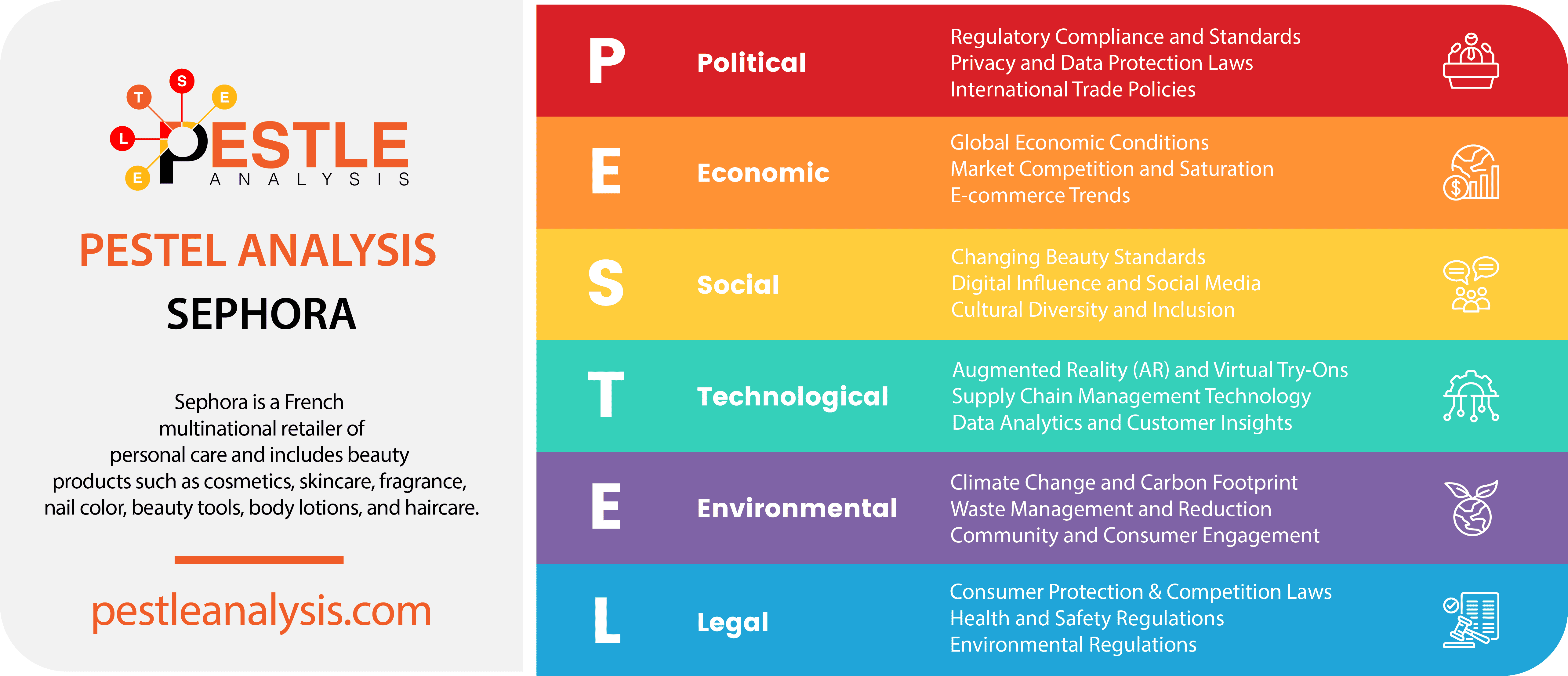Explore our Sephora PESTLE Analysis to understand how political, economic, social, tech, legal, and environmental factors shape its strategy.
In today's article, we are conducting a Sephora PESTLE Analysis to examine how political, economic, social, technological, legal, and environmental factors affect Sephora. For the leading multinational chain of personal care and beauty stores, understanding these factors is crucial for strategic planning and decision-making.
PESTLE Analysis of Sephora
PESTLE analysis is a strategic planning framework used in business analysis. It investigates the Political, Economic, Sociocultural, Technological, Legal, and Environmental factors that affect a company or an industry.
Sephora Political Factors
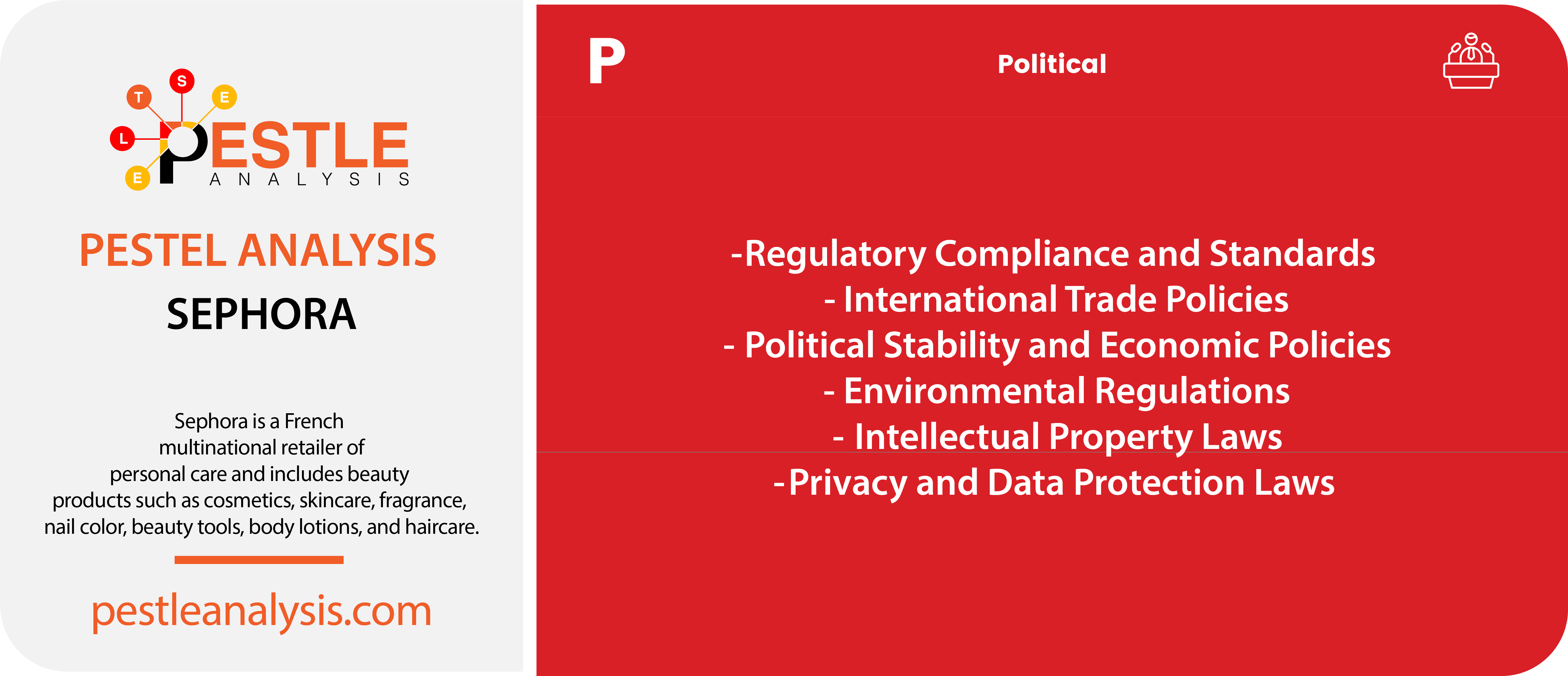
- Regulatory Compliance and Standards: Sephora operates in numerous countries, each with its regulatory frameworks governing the beauty and personal care industry. These regulations can cover a wide range of aspects, from product ingredients, packaging, and advertising claims to health and safety standards. Compliance with such regulations is paramount for Sephora to avoid legal penalties and maintain its brand reputation.
- International Trade Policies: Tariffs, trade agreements, and import/export regulations significantly affect Sephora's operations, especially since it sources products globally and operates in various international markets. Changes in these policies could impact Sephora's cost structures and supply chain efficiency, necessitating strategic adjustments.
- Political Stability and Economic Policies: The political climate in countries where Sephora operates can influence its business operations. Political instability, changes in government, or shifts in economic policy can affect consumer spending, currency exchange rates, and overall market attractiveness. Sephora needs to be agile and adaptable to navigate these uncertainties.
- Environmental Regulations: With increasing political attention on environmental issues, regulations related to sustainability practices, waste management, and carbon footprint reduction are becoming more stringent. Sephora has to ensure that its operations, from product sourcing to packaging and distribution, comply with these evolving standards to avoid fines and meet consumer expectations for sustainable practices.
- Intellectual Property Laws: As a retailer that also develops its private label products, Sephora must navigate the complex landscape of intellectual property rights across different jurisdictions. Political factors such as the enforcement of copyright and patent laws can impact Sephora's product offerings and brand exclusivity.
- Privacy and Data Protection Laws: With the rise of e-commerce and digital marketing, Sephora collects and processes significant amounts of customer data. Political factors include the enactment and enforcement of privacy and data protection laws, such as the GDPR in Europe, which affect how Sephora can collect, use, and store consumer data.
In summary, political factors play a crucial role in shaping Sephora's business environment. By staying informed and adaptive to these political dynamics, Sephora can better navigate potential challenges and leverage opportunities to sustain and grow its global presence in the beauty industry.
Sephora Economic Factors
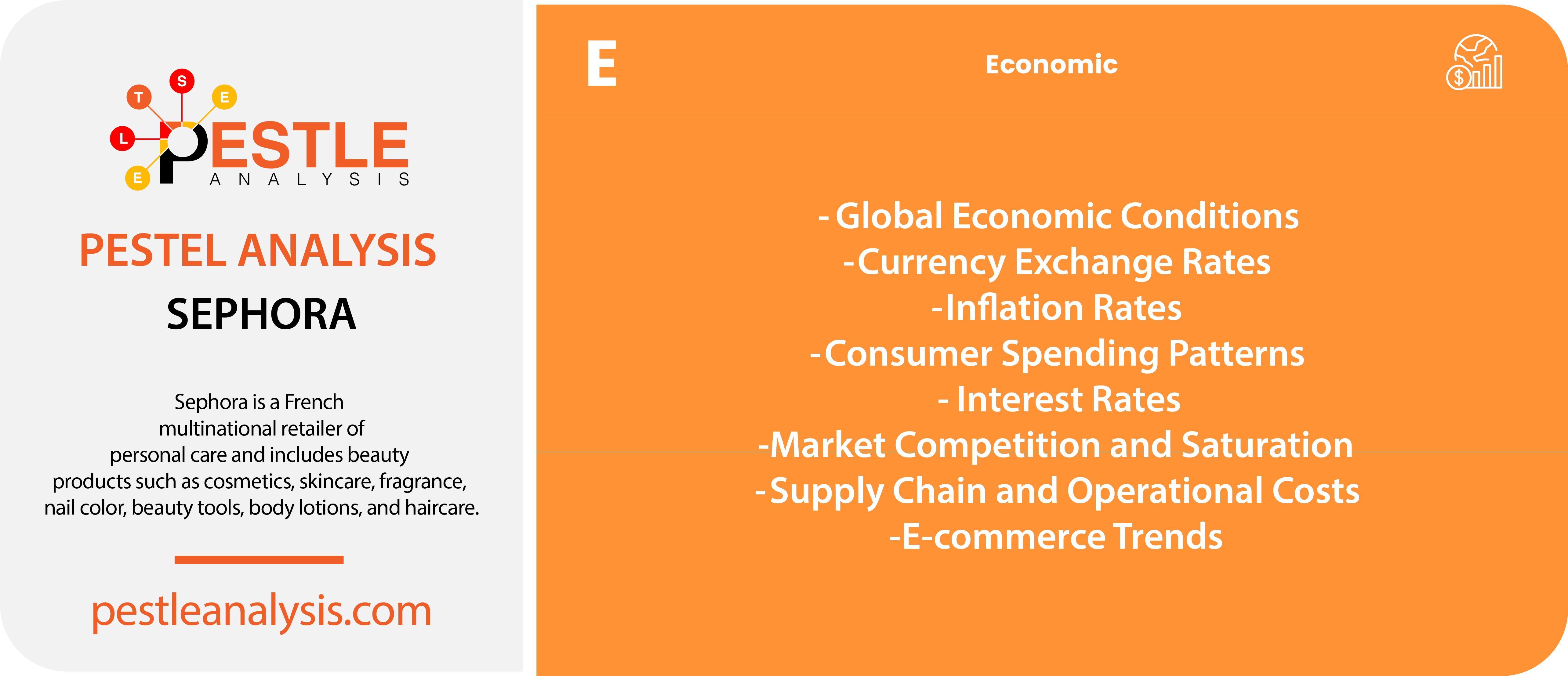
- Global Economic Conditions: The overall health of the global economy influences consumer spending power. In times of economic growth, consumers may be more willing to spend on discretionary items like beauty products. Conversely, during economic downturns, consumers might cut back on such spending, affecting Sephora's sales.
- Currency Exchange Rates: As a multinational corporation, Sephora deals with multiple currencies. Fluctuations in exchange rates can affect its profitability, cost of goods sold, and pricing strategies. For example, a strong US dollar could make purchasing products more expensive in other countries, potentially reducing demand.
- Inflation Rates: Inflation can increase the cost of goods and services Sephora needs to operate, such as products, packaging, and retail space leases. These cost pressures might force Sephora to adjust its pricing, which could impact consumer demand and profitability.
- Consumer Spending Patterns: Economic factors such as employment rates, disposable income levels, and consumer confidence affect how much money people are willing to spend on beauty and personal care products. Sephora needs to monitor these trends closely to tailor its product offerings and marketing strategies accordingly.
- Interest Rates: Interest rates influence the cost of borrowing money for both businesses and consumers. For Sephora, higher interest rates could increase the cost of financing its operations or expansion efforts. For consumers, higher rates might reduce the disposable income available for spending on non-essential items.
- Market Competition and Saturation: The economic environment affects the level of competition and market saturation. In robust economies, new entrants might be encouraged to join the market, increasing competition. Conversely, in weaker economies, only strong players like Sephora may withstand the downturn, potentially leading to less competition but also reduced consumer demand.
- Supply Chain and Operational Costs: Economic factors such as fuel prices, labor costs, and raw material costs directly affect Sephora's supply chain efficiency and operational expenses. Variations in these costs can impact Sephora's margins and necessitate adjustments in pricing or operations to maintain profitability.
- E-commerce Trends: The shift towards online shopping has been accelerated by economic factors, including technological advancements and changes in consumer behavior. Sephora's investment in its e-commerce platform and digital marketing can be influenced by these trends, requiring continuous adaptation to meet consumer expectations and leverage online sales channels effectively.
Understanding and adapting to these economic factors is vital for Sephora to navigate the complex global market, optimize its operational and financial performance, and maintain its competitive edge in the beauty and personal care industry.
Sephora Social Factors
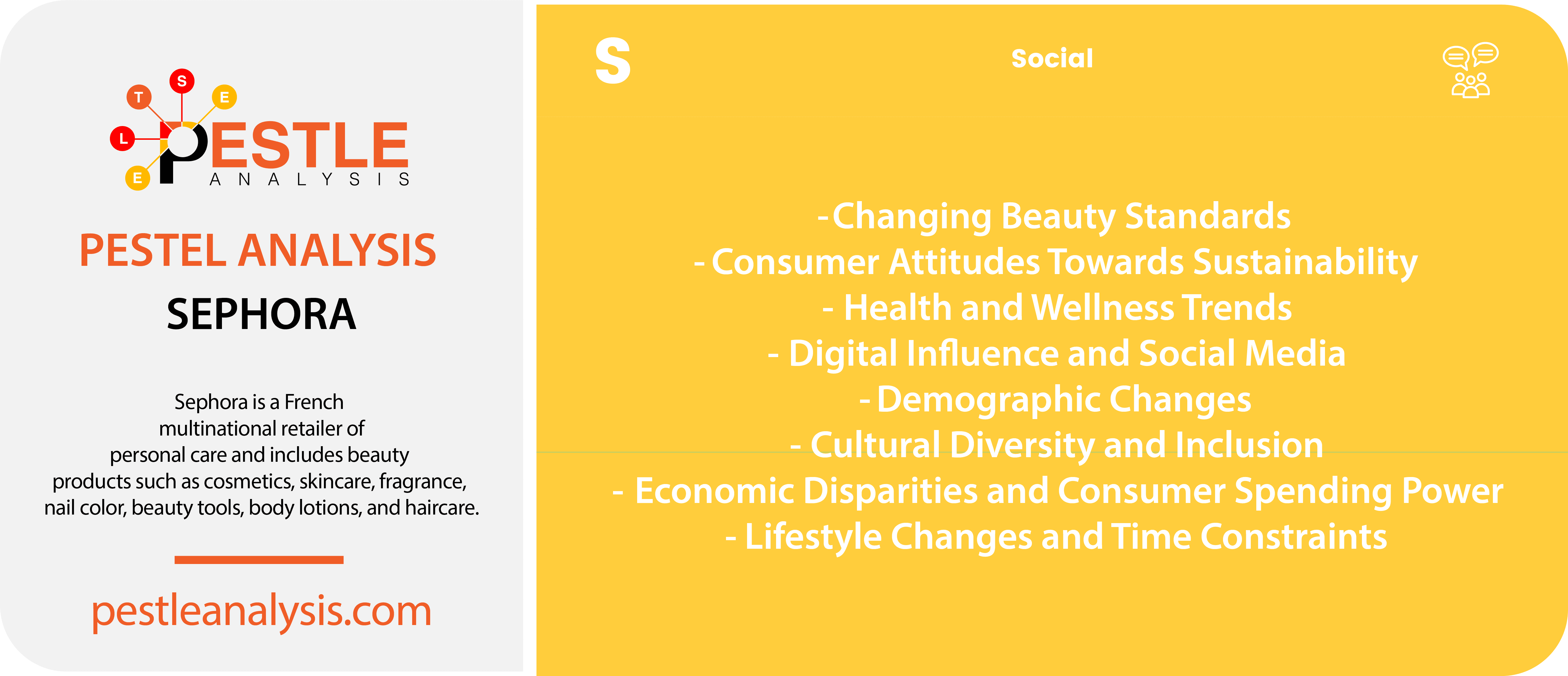
- Changing Beauty Standards: Beauty standards evolve over time and vary across cultures. Trends such as natural beauty, inclusivity in beauty products (catering to a wide range of skin tones and types), and male grooming have gained prominence. Sephora's ability to anticipate and respond to these changing standards by offering a diverse range of products can significantly affect its market position and brand perception.
- Consumer Attitudes Towards Sustainability: There's a growing societal push towards sustainability and ethical consumption. Consumers are increasingly looking for eco-friendly products, cruelty-free brands, and sustainable packaging. Sephora's commitment to these values, reflected in its product selection and corporate practices, can enhance its reputation and attract a segment of environmentally and ethically conscious consumers.
- Health and Wellness Trends: The rise in consumer interest in health and wellness influences beauty preferences, with a growing demand for skincare products over makeup, and products featuring natural, organic, or clean ingredients. Sephora's ability to cater to this demand by curating its product range accordingly can drive customer loyalty and attract new customers.
- Digital Influence and Social Media: The role of social media influencers, beauty bloggers, and online reviews has become paramount in shaping consumer preferences and purchasing decisions. Sephora's engagement on digital platforms, collaborations with influencers, and leveraging user-generated content can enhance its brand visibility and influence consumer behavior.
- Demographic Changes: Changes in demographics, such as aging populations in some markets, can affect demand for certain types of beauty products. Sephora's ability to offer products that cater to the needs of different age groups, including anti-aging skincare and cosmetics suited for older skin types, can broaden its customer base.
- Cultural Diversity and Inclusion: As societies become more diverse, there's a higher expectation for brands to be inclusive in their product ranges, marketing, and representation. Sephora's efforts to embrace diversity in its beauty products and campaigns can resonate with a wider audience, promoting a positive brand image.
- Economic Disparities and Consumer Spending Power: Social factors also include economic disparities within societies, which influence consumer spending power on beauty products. Sephora's strategy to offer products across different price points and value propositions can help it cater to a broad spectrum of consumers.
- Lifestyle Changes and Time Constraints: Busy lifestyles and time constraints influence consumer preferences for multi-functional and easy-to-use beauty products. Sephora's adaptation to these needs by offering such products can meet consumer expectations for convenience and efficiency.
In conclusion, Sephora's ability to understand and adapt to these social factors is crucial for staying relevant and competitive in the dynamic beauty industry. By aligning its products, marketing strategies, and corporate practices with societal trends and consumer expectations, Sephora can continue to grow its brand and maintain its position as a leading beauty retailer globally.
Sephora Technological Factors
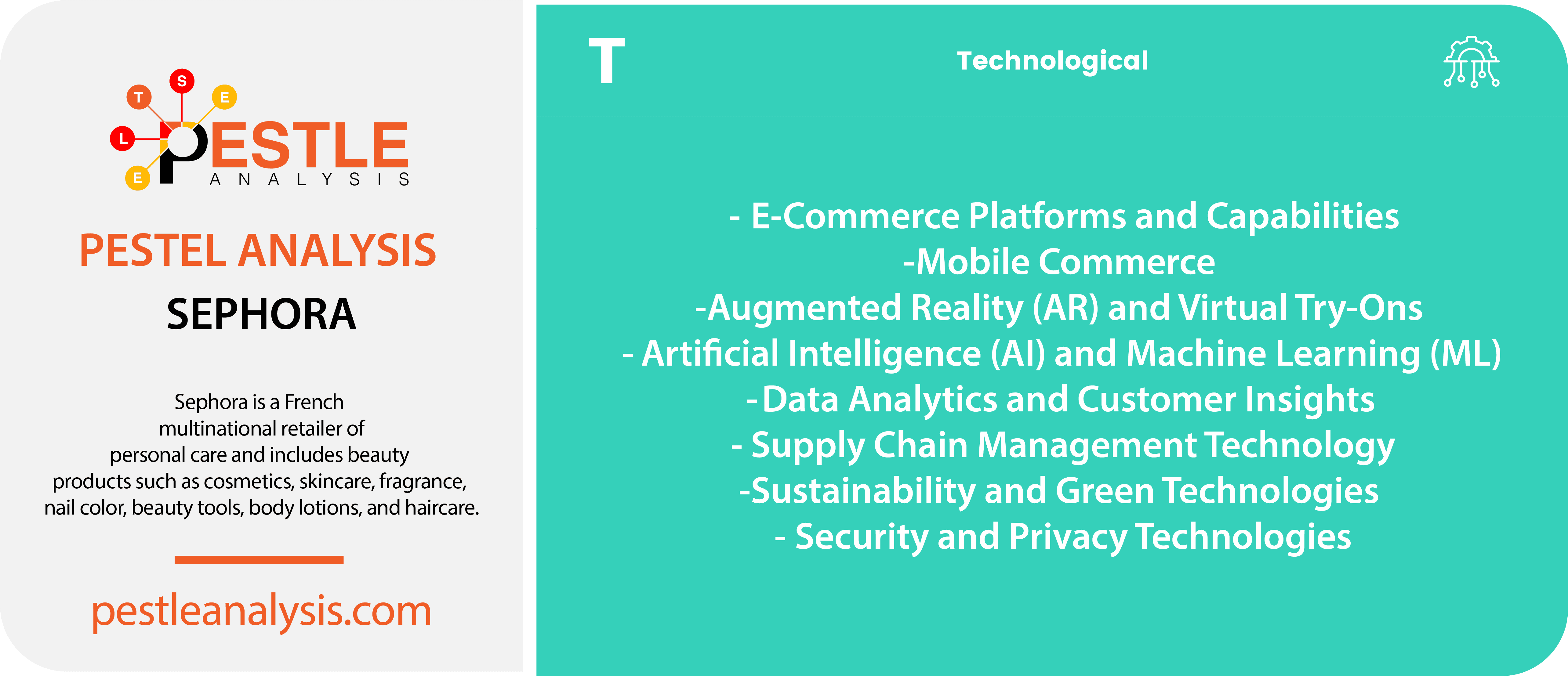
- E-Commerce Platforms and Capabilities: Continuous improvements and innovations in e-commerce technology affect Sephora's online sales. User-friendly interfaces, personalized recommendations, and seamless payment options enhance customer experience and drive online revenue.
- Mobile Commerce: The increasing use of smartphones for shopping makes mobile commerce capabilities crucial. Sephora needs to ensure its mobile app and website are optimized for shopping, customer engagement, and loyalty programs to meet consumer expectations for convenience and accessibility.
- Augmented Reality (AR) and Virtual Try-Ons: AR technology allows customers to virtually try on makeup and skincare products, significantly enhancing the online shopping experience. Investing in AR can help Sephora reduce the gap between online and in-store experiences.
- Artificial Intelligence (AI) and Machine Learning (ML): AI and ML can be used for personalized marketing, product recommendations, and customer service (e.g., chatbots). These technologies can help Sephora understand customer preferences better and tailor its offerings to individual needs.
- Data Analytics and Customer Insights: Advanced data analytics technologies enable Sephora to analyze vast amounts of customer data to gain insights into shopping behaviors, trends, and preferences. This information can inform product development, marketing strategies, and inventory management.
- Supply Chain Management Technology: Technologies such as RFID (Radio-Frequency Identification) and IoT (Internet of Things) can improve inventory management and tracking, reducing losses and optimizing stock levels across Sephora's retail and online channels.
- Sustainability and Green Technologies: As consumers become more environmentally conscious, investing in green technologies for sustainable packaging, energy-efficient stores, and environmentally friendly products becomes increasingly important for maintaining brand reputation and customer loyalty.
- Security and Privacy Technologies: With the growing volume of online transactions, ensuring the security of customer data and transactions is paramount. Sephora must invest in advanced cybersecurity measures to protect against data breaches and maintain customer trust.
By leveraging these technological advancements, Sephora can enhance its operational efficiency, offer innovative and personalized shopping experiences, and sustain its leadership in the competitive beauty and personal care industry.
Sephora Legal Factors
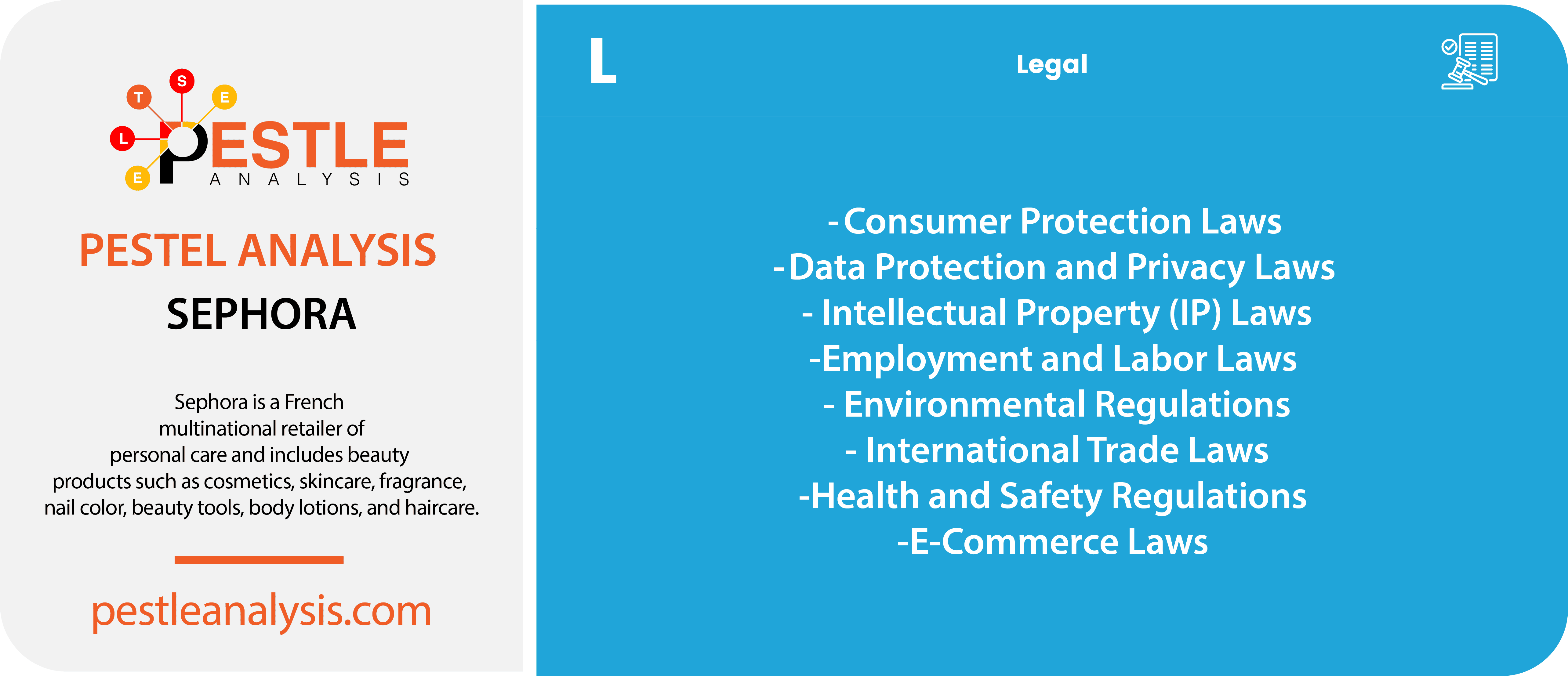
- Consumer Protection Laws: These regulations are designed to safeguard consumers against unfair practices and ensure that products meet safety standards. Sephora must ensure compliance with consumer protection laws in all regions it operates, covering aspects such as product labeling, safety, advertising claims, and returns policies.
- Data Protection and Privacy Laws: With a significant online presence and customer data collection through various channels, Sephora must adhere to data protection and privacy laws like the General Data Protection Regulation (GDPR) in Europe and similar regulations worldwide. These laws dictate how customer information is collected, stored, used, and shared.
- Intellectual Property (IP) Laws: Sephora, known for its exclusive product lines and brand collaborations, must protect its IP rights, including trademarks, patents, and copyrights. This involves enforcing its rights against counterfeit products, unauthorized use of its brand, and ensuring it does not infringe on the IP rights of others.
- Employment and Labor Laws: As a global employer, Sephora must comply with the employment laws of the countries in which it operates. This includes fair labor practices, minimum wage laws, working conditions, non-discrimination policies, and employee benefits.
- Environmental Regulations: Legal requirements related to environmental protection impact Sephora, especially concerning product packaging, waste management, and the sourcing of ingredients. Compliance with these laws is crucial for corporate responsibility and maintaining a positive brand image among environmentally conscious consumers.
- International Trade Laws: Since Sephora sources products from and operates in many countries, it must navigate international trade laws, including tariffs, import/export regulations, and customs procedures. Changes in these laws can affect Sephora's supply chain and product pricing strategies.
- Health and Safety Regulations: These regulations govern the safety of products sold and the health and safety of employees and customers within Sephora's stores. Compliance with health and safety standards is essential for avoiding legal penalties and ensuring the wellbeing of employees and customers alike.
- E-Commerce Laws: Operating an online sales platform subjects Sephora to specific e-commerce regulations that may vary by country. These can include laws on online transactions, digital marketing, consumer rights in e-commerce, and cross-border sales practices.
For Sephora, careful legal compliance not only minimizes the risk of fines and legal disputes but also supports its reputation as a responsible and customer-centric company. Staying abreast of legal changes and proactively adapting to new regulations is vital for Sephora's ongoing success and expansion efforts.
Sephora Environmental Factors
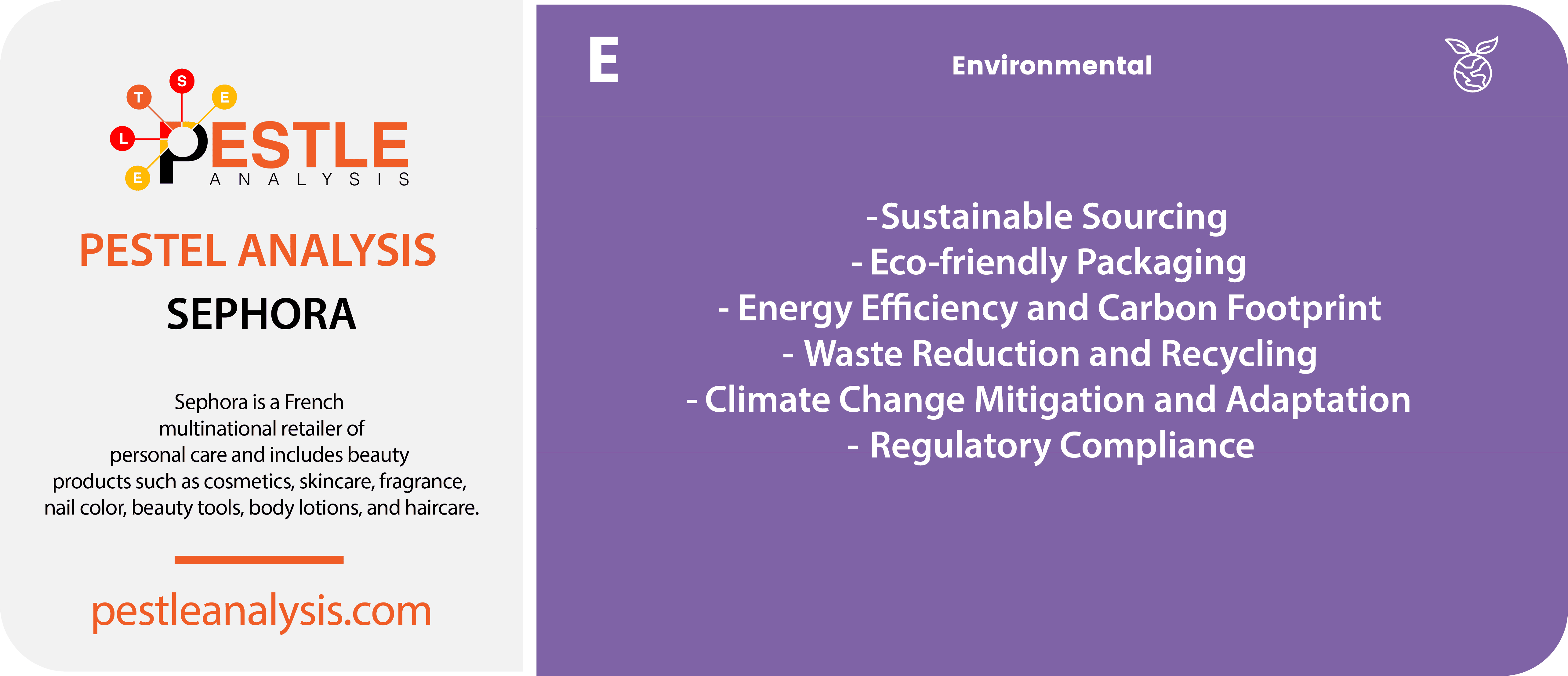
- Sustainable Sourcing: Consumers are increasingly concerned about the origins of the products they use, preferring items that are ethically sourced and produced with minimal environmental impact. Sephora must ensure that its products, especially those under its private label, are sourced from suppliers practicing sustainable methods. This includes using ingredients that are renewable and harvested ethically, and ensuring that supply chains do not contribute to deforestation or habitat destruction.
- Eco-friendly Packaging: The cosmetics industry is notorious for its use of plastic and non-recyclable materials in product packaging. Sephora has the opportunity to lead by example by investing in biodegradable, recyclable, or reusable packaging solutions. Reducing packaging waste not only appeals to environmentally conscious consumers but also aligns with global efforts to tackle plastic pollution.
- Energy Efficiency and Carbon Footprint: Retail operations consume significant amounts of energy, from lighting and heating stores to logistics and distribution networks. Implementing energy-efficient practices and technologies in stores, offices, and throughout the supply chain can significantly reduce Sephora's carbon footprint. Moreover, investing in renewable energy sources for its operations can further demonstrate Sephora's commitment to environmental stewardship.
- Waste Reduction and Recycling: Beyond packaging, Sephora can implement initiatives aimed at reducing waste across all areas of its business, from minimizing product waste to encouraging recycling among customers. Programs that allow customers to return used products for recycling or refillable product options can enhance Sephora's environmental credentials and attract eco-conscious consumers.
- Climate Change Mitigation and Adaptation: As climate change continues to pose a significant threat to global ecosystems, businesses are expected to play their part in mitigating its effects. Sephora can contribute by reducing its greenhouse gas emissions, using sustainable materials, and supporting environmental conservation projects. Additionally, adapting its operations to be more resilient against the impacts of climate change, such as extreme weather events, is crucial for long-term sustainability.
- Regulatory Compliance: Environmental regulations are becoming stricter as governments worldwide aim to tackle pressing environmental issues. Compliance with these regulations is non-negotiable for Sephora, requiring it to stay informed about and adapt to new environmental laws and standards in every market it operates.
By proactively addressing these environmental factors, Sephora can not only minimize its environmental impact but also strengthen its brand reputation, meet regulatory requirements, and cater to the growing demand for sustainable products and practices among consumers. This environmental consciousness is not just good ethics; it's also sound business strategy in today's increasingly eco-aware market.
Congrats! You have now completed a PESTLE Analysis of Sephora!
What’s next after delving into Sephora PESTLE Analysis?
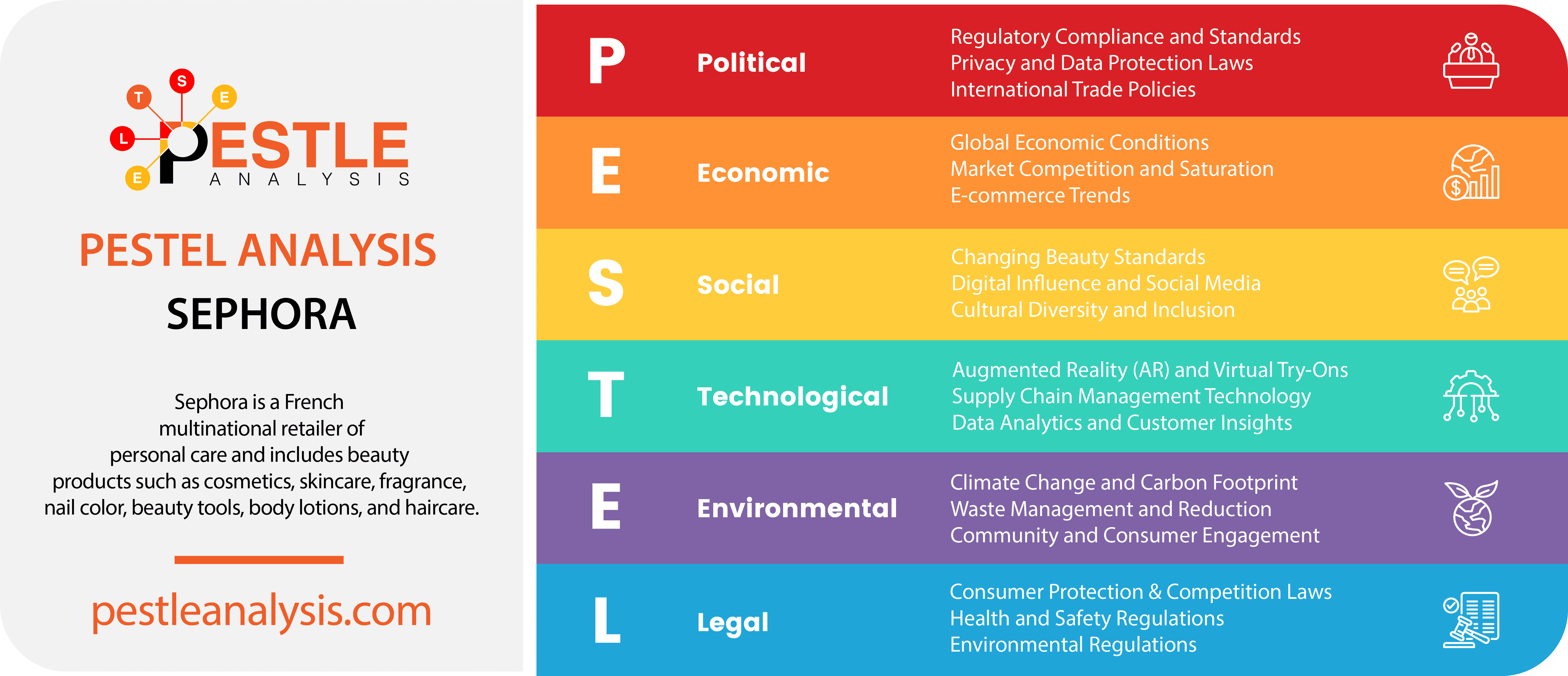
If you’re captivated by the intricacies of PESTLE analysis and eager to explore its impact across different sectors, our website here at PESTLEanalysis is the perfect place for you with many examples. We offer an extensive collection of resources, from in-depth analyses tailored to various industries to enlightening guides that uncover every aspect of the PESTEL framework.
But we don’t stop there! Our site is also home to an array of SWOT analyses, ensuring you gain a comprehensive perspective on strategic planning. Whether you're a student on the path of learning, a professional aiming to refine your analytical skills, or someone with a keen interest in business strategies, our website provides all the tools necessary for your success.
Don't delay your journey into the world of business analysis any longer. Visit our site now and start a journey that promises to enrich your understanding of PEST and SWOT analyses, offering insights and knowledge that will propel you forward in your endeavors!

